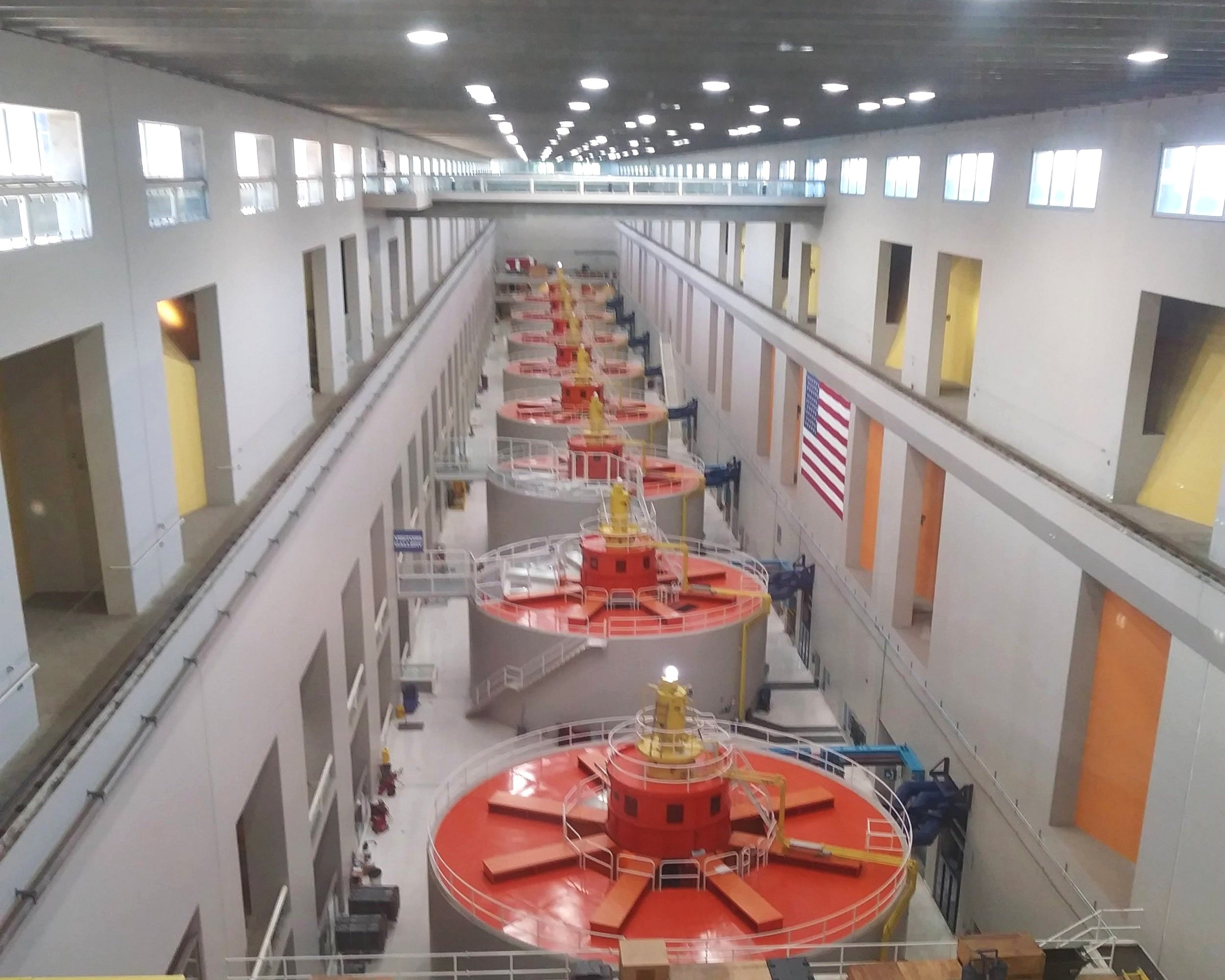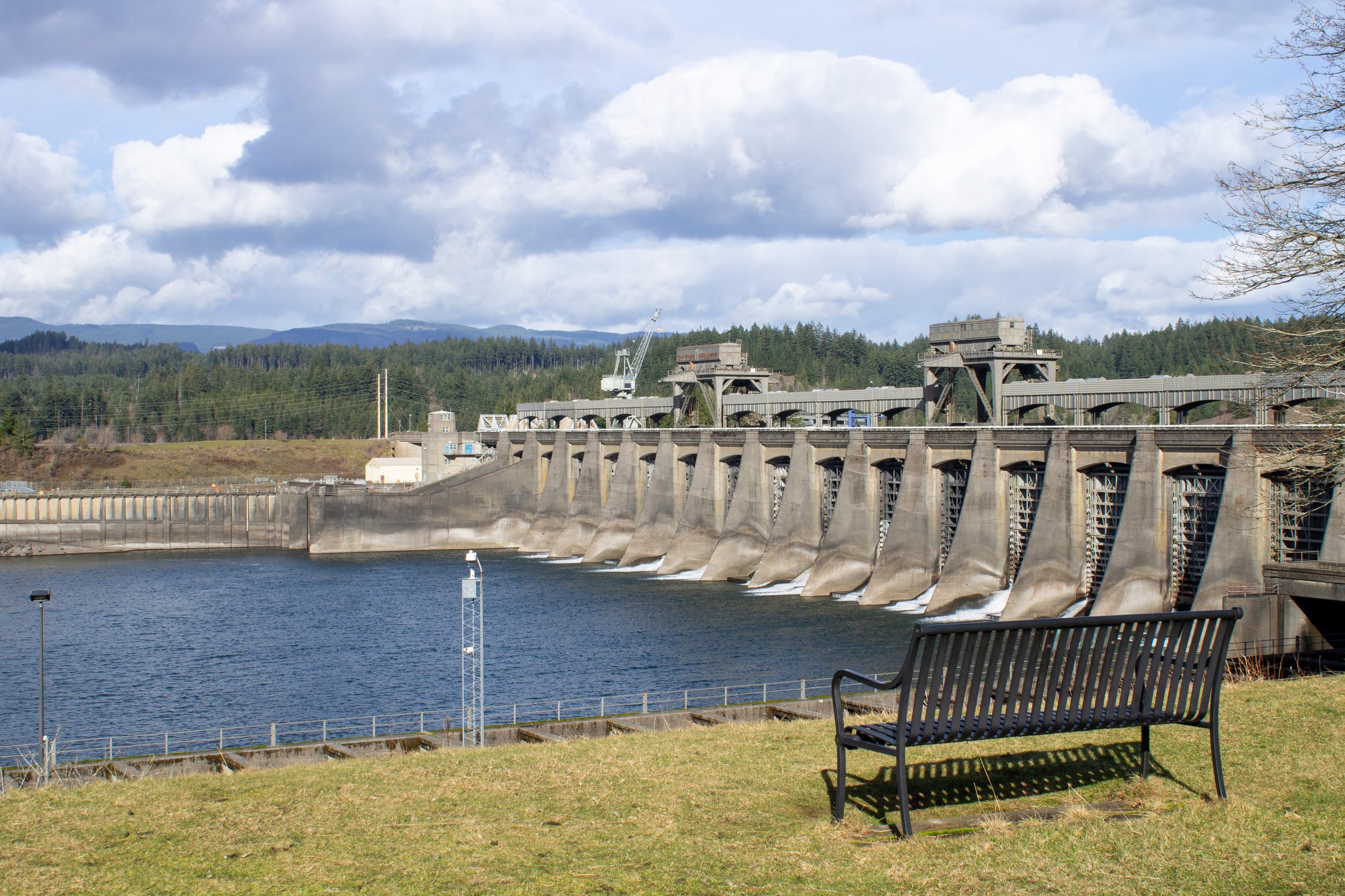How to Watch Salmon Migrate at Bonneville Dam
One of Earth’s great migrations passes right by Portland, Oregon, when hundreds of thousands of salmon and steelhead travel up the Columbia River on their way back to their birth streams and rivers. Underwater viewing windows at Bonneville Dam create a unique opportunity to watch these fish navigate through the fish ladders as they move upstream. While you’re visiting Bonneville Lock and Dam, you can see the innards of a working hydroelectric power plant, find observation decks overlooking the Columbia Gorge, watch barges enter the huge navigation lock, and visit the most famous resident of Bonneville Fish Hatchery, 10-foot-long Herman the Sturgeon. Here is everything you need to know about visiting Bonneville Dam.
Take a self-guided tour to see Bonneville’s generators
Know before you go
It’s free to visit Bonneville Dam and its fish ladders. You don’t need a pass or permit to park.
Bonneville Dam has two public entrances: one in Oregon and one in Washington. Both sides have a visitor’s center, restrooms, picnic tables, a powerhouse, and underwater viewing windows. The fish hatchery and navigation lock are on the Oregon side. You can’t walk or drive between Oregon and Washington using the dam. To see both sides, you would need to cross the river using the Bridge of the Gods in Cascade Locks.
Dogs are not allowed at Bonneville Dam.
There is ADA access throughout the facility, including parking, restrooms, and sidewalks around the visitor areas. Elevators take you between floors to reach the fish-viewing windows.
You can visit Bonneville Dam anytime throughout the year, but the best time to see fish in the underwater viewing windows is when adult Chinook and coho salmon are migrating up the Columbia River from August - October, particularly September. The peak of the salmon run past the Bonneville Dam usually happens during the first two weeks of September.
Weapons are not allowed at Bonneville Dam.
The visitor’s centers in Oregon and Washington are open 9 AM - 5 PM, 7 days a week. They close on Thanksgiving, Christmas, and New Year’s Day. Volunteers can help answer questions and give directions.
The Bonneville Navigation Lock has a third visitor’s center that is open seasonally from Memorial Day until Labor Day, 1 PM - 4 PM. The navigation lock operates whenever a boat needs to pass the dam, usually about 8-10 times a day. It does not have a set schedule.
Look for a large picnic area on Robins Island (Oregon side), including a covered picnic shelter. Or, head to Cascade Locks for lunch to check out one of the breweries in town.
Fish ladders and the salmon migration
Fish ladder
You can spot fish moving through the ladder from above
Salmon in the Pacific Northwest have a life cycle that involves one of the world’s most impressive migrations. Their lives begin in inland streams and rivers where they hatch from nests of eggs called redds. They remain near their birthplace until they grow large enough to migrate to the Columbia River and then to the Pacific Ocean. They’ll begin the journey as fingerlings, so named for being about the size of a finger.
The Washington fish ladder
Salmon spend most of their lives in the ocean, then return to their birthplace to spawn. Some will go as far as Idaho during this journey. After spawning, they will die and their bodies help recycle nutrients from the ocean back to inland forests. Unlike salmon, steelhead can spawn without dying.
Head downstairs to find the fish-viewing windows
Many dangers threaten salmon and steelhead during their migration, from predatory birds to sea lions to boats and urban pollution. Dams are one of their biggest challenges. The fish ladders at Bonneville Dam help salmon navigate past the dam and continue upstream without having to pass through the dangerous turbines of the generators. Millions of fish use Bonneville’s ladders every year.
Fish navigate the ladder
When to visit the fish ladders
Pacific lampreys
Although you might see fish in the ladders throughout the year, the most interesting time to visit is during fall when adult Chinook and coho salmon migrate up the Columbia to spawn, peaking in early September. Some of these fish can be over three feet long and weigh more than 50 pounds. Besides salmon, look for steelhead, white sturgeon, and eel-like Pacific lampreys. You might also spot an opportunistic bird diving down into the fish ladders. Here is a rough timeline of what to look for based on the season:
Chinook salmon: April through September, largest numbers are in the fall
Coho salmon: September
Sockeye salmon: July
Steelhead: July through September
Shad: June
Chum salmon: September - November (rare)
Pink salmon: August - October
Pacific lampreys: May - September
White sturgeon: rare
A cormorant dives into the fish ladder near a group of lampreys
Bonneville Lock and Dam
Observation deck at the Bradford Island Visitor Center
A self-guided tour of Bonneville Lock and Dam is my official nomination for the More Interesting Than It Sounds Award. When you’re surrounded by magnificent Columbia Gorge hiking trails and waterfalls, exploring what is essentially a public utility can be a hard sell as a destination. I know tastes vary, but normally if someone recommended an excursion to admire engineering achievements of the 1930s, I would remember an urgent dentist appointment. All this preamble is to say that even with little to no interest in levers, gears, or turbines, Bonneville Dam is a worthwhile visit.
The Bonneville Dam spillway
First, there is the staggering scale of it. At 170 feet high and wide enough to span the Columbia River, Bonneville Lock and Dam is a behemoth. One of the country’s largest hydroelectric systems, it generates enough power to supply around 900,00 homes, or a city about the size of Portland. The US Army Corps of Engineers completed the original dam, spillway, and navigation lock in 1938, a project both to create a source of electric power and to alleviate the high levels of unemployment during the Great Depression. Since then, the Corps added a second powerhouse and larger navigation lock.
The end of the fish ladder is typical of how natural beauty surrounds industrial infrastructure at Bonneville Dam
At least as interesting as the dam itself are its surroundings. Bonneville Dam spans a unique section of the Columbia River where a landslide narrowed its course. Juxtaposed with the steel and concrete of the dam are the rising hills of the Columbia Gorge covered with conifer forests. Fog often settles between the hills, creating a moody backdrop for the dam. Downriver, you might see sea lions that traveled from the Pacific Ocean to hunt salmon in the Columbia River. Overhead, watch for bald eagles and osprey. Observation decks at the visitor’s centers provide excellent vantage points to admire the unlikely combination of industrial efficiency and natural beauty.
Fish hatchery and sturgeon viewing window
A mallard watches rainbow trout at Bonneville Fish Hatchery
If you visit Bonneville Dam on the Oregon side, it’s worth stopping at the Bonneville Fish Hatchery. This hatchery is Oregon’s largest, raising Chinook and coho salmon. With flower gardens, tree-lined walkways, and farmhouse-style buildings, the grounds feel more like a rural bed and breakfast than a working fish hatchery. Only the rows of large tanks give it away. Nets over the tanks protect the tiny, often jumping, juvenile fish from raptors overhead. In the distance, you’ll see the slopes of the Columbia Gorge.
Rainbow trout
Follow the paths to the viewing ponds to find a colorful population of rainbow trout. They are not raised here but are brought in for beauty’s sake alone. For a quarter you can feed them. While watching the trout I noticed many coins at the bottom of the viewing pond. How maddening, I thought, if I were a fish to have coins thrown at me when they could just as easily have been spent on throw-able snacks. Throw fish food or nothing.
Sturgeons swim behind the underwater viewing window
The highlight of the Bonneville Fish Hatchery is the underwater viewing window where you can watch massive sturgeon swimming in the depths. On the otherwise uncrowded day I visited, people were just shy of elbowing each other out of the way for a chance to approach the glass and see Bonneville’s most famous fish, the 80-year-old,10-foot-long, 500-pound white sturgeon named Herman. Their interest is understandable. Sturgeons belong to a line of fish that dates back to prehistory, around 200 million years old. They are bottom-dwellers with cartilaginous bodies like sharks and round suction-like mouths. At the viewing window, Herman and his fellow sturgeons swim up to the glass, bringing you eye to eye with creatures that look like something that Odysseus would have fought, to his detriment.
Hiking near Bonneville Dam
Bonneville Dam is near excellent trails in both Oregon and Washington, including many waterfall hikes. Here are a few great choices nearby.
In Oregon:
Wahclella Falls
If you pass under I-84 from Bonneville Dam, you’ll be at the trailhead that begins the easy, 2-mile hike to Wahclella Falls. The trail follows Tanner Creek until it reaches magnificent Wahclella Falls, a multi-tiered waterfall in a basalt chasm. Use the Northwest Forest Pass or America the Beautiful Pass to park.
Punch Bowl Falls
The always beautiful and occasionally harrowing Eagle Creek Trail follows the Eagle Creek Canyon past dramatic cliffs and waterfalls. The trail itself is one of the most interesting parts of this hike, at times involving cable handrails along a narrow ledge that hugs a basalt cliff. A 4.8-mile hike will bring you to Punch Bowl Falls. For a more ambitious day, the trail continues out to Tunnel Falls for a 12-mile hike. Use the Northwest Forest Pass or America the Beautiful Pass to park.
Dry Creek Falls
Starting from the Bridge of the Gods in Cascade Locks, you can follow the Pacific Crest Trail for just over 2 miles (one-way) to reach lovely Dry Creek Falls. This waterfall makes a straight plunge over a cliff of columnar basalt before flowing out as picturesque Dry Creek. Use the Northwest Forest Pass or America the Beautiful Pass to park.
In Washington:
North Bonneville Trail
Just across Highway 14 from the Bonneville Visitor’s Center in Washington is the North Bonneville Trailhead. From here, you can begin a 5.6-mile hike through the forest out to Gillette Lake. Use the Northwest Forest Pass or America the Beautiful Pass to park.
Hamilton Island and the Columbia River
Just west of Bonneville Dam, Hamilton Island has a pleasant network of trails that will bring you along the shore of the Columbia River and fantastic views of the Gorge. You don’t need a pass to park here and I’ve never seen it get crowded. It’s also a great choice for a Columbia Gorge hike on a rare sunny day in winter when you want to feel the sunshine.
Beacon Rock
Beacon Rock State Park has a wonderful variety of hiking trails, most notably the 1.8-mile hike up its namesake Beacon Rock, a spire of basaltic andesite that was the core of a volcano. To try out one of the best waterfall hikes in the Columbia Gorge, cross Highway 14 and head to Hardy Falls, Rodney Falls, and Pool of the Winds. The hike to the falls is an easy 2.5-mile trek. For more of a challenge, you can continue to the summit of Hamilton Mountain for a 5-mile hike with excellent Columbia Gorge views.
Natural places to see fish migrating and spawning
The Salmon River at Wildwood Recreation Site
After passing Bonneville Dam, migrating adult salmon will continue along the Columbia River and then make their way up its tributaries until they reach their birthplace. Near Portland, you might see spawning salmon and steelhead in places like the Sandy River, Salmon River, Clackamas River, Washougal River, Wilson River, and Nehalem River. In the Columbia Gorge, look for them in Eagle Creek or Herman Creek.
Consider checking out Wildwood Recreation Site to watch for fish spawning in the Salmon River. Here you’ll also find easy hiking trails, interpretative information, and an underwater fish viewing window. The nearby Salmon River Trail is a less developed destination that also has good salmon viewing potential. Closer to Portland, head to Oxbow Regional Park to look for salmon in the Sandy River. In Washington, you might see them at Lucia Falls Park or Sunset Falls.
Lucia Falls
To spot salmon, it can help to watch for ripples or waves in the water. Look for areas of the riverbed with lots of gravel and try to get above the level of the river for a better field of view. Make sure not to disturb the fish, which can disrupt their spawning. The best times to look for them are September and October but you might see them into the winter.
Getting there
To reach the Oregon Visitor’s Center on Bradford Island from Portland, follow I-84 East until Exit 40. Take a left to head toward Robins Island, Bradford Island, and Bonneville Dam. Signs will direct you to the Visitor’s Center. The drive takes about 45 minutes.
To reach the Washington Visitor’s Center from Portland, either take Highway 14 East until Dam Access Rd or take I-84 and cross into Washington using the Bridge of the Gods in Cascade Locks ($3 toll). The drive will take a little less than an hour.
Enjoy the fish!
With love,
Emma
Explore nearby
Find the best things to do in Hood River.
Hike to nearby Elowah Falls and Upper McCord Creek Falls.
Check out the 10 best waterfall hikes near Multnomah Falls.
Take in the Columbia Gorge views at Vista House.




























